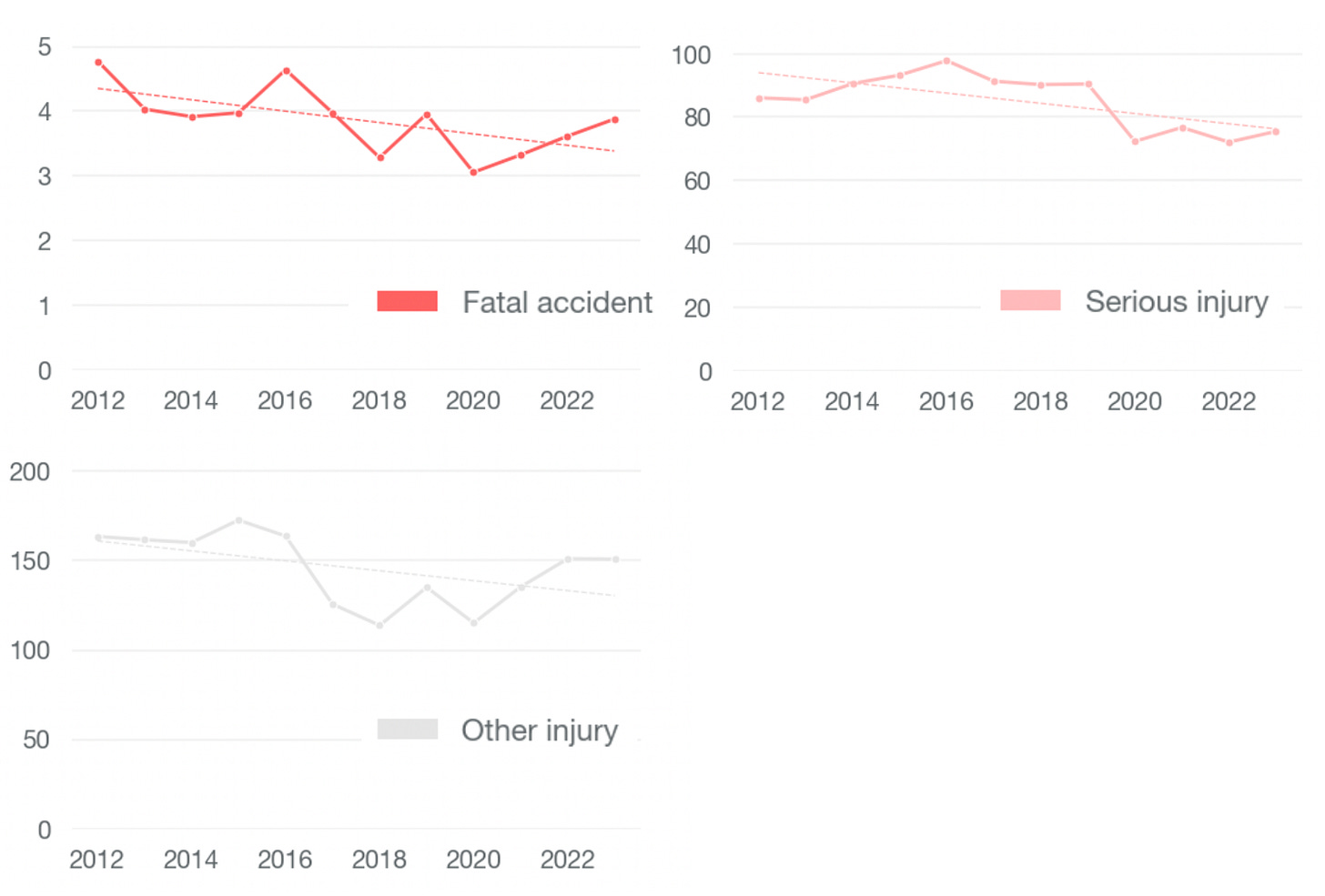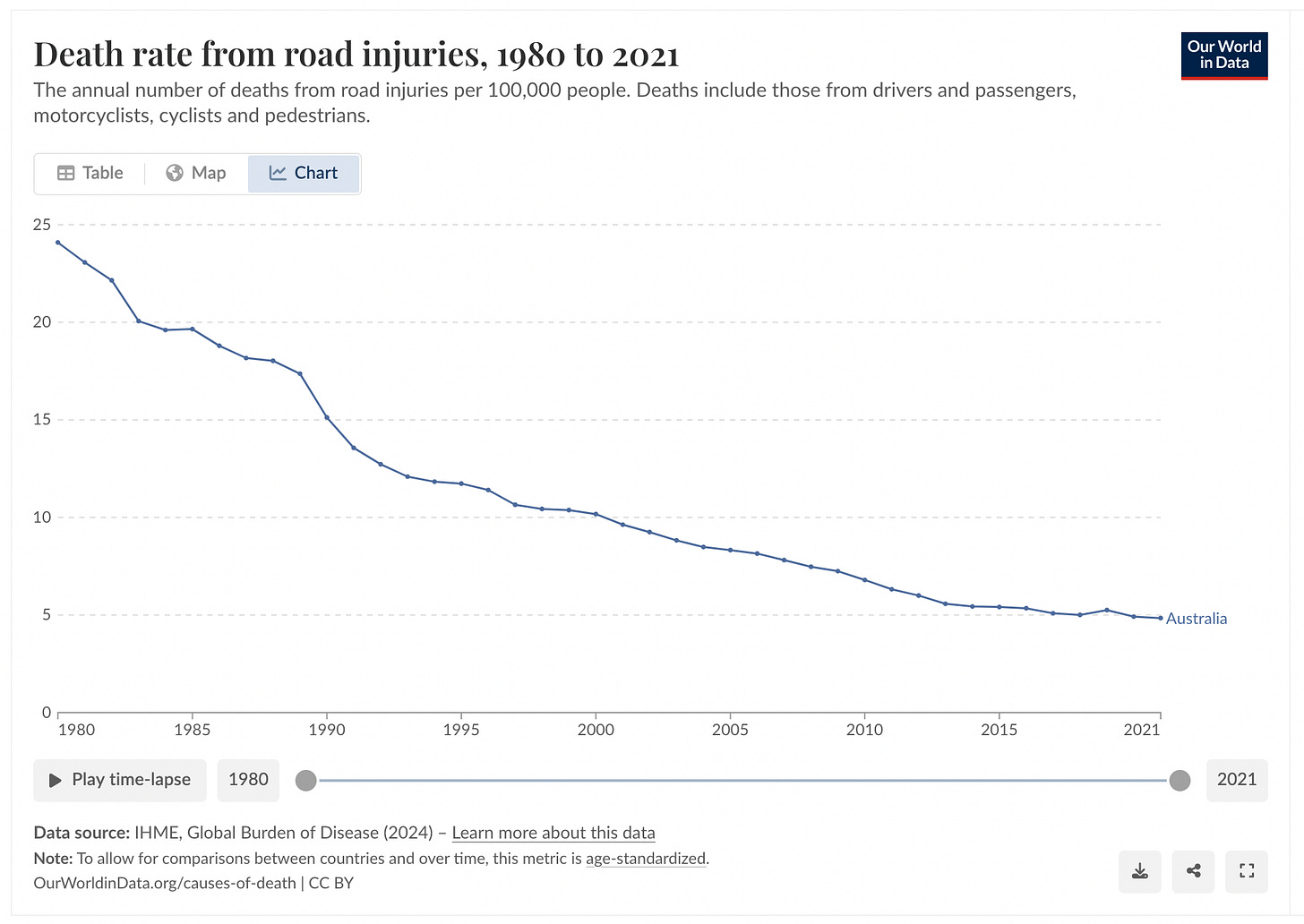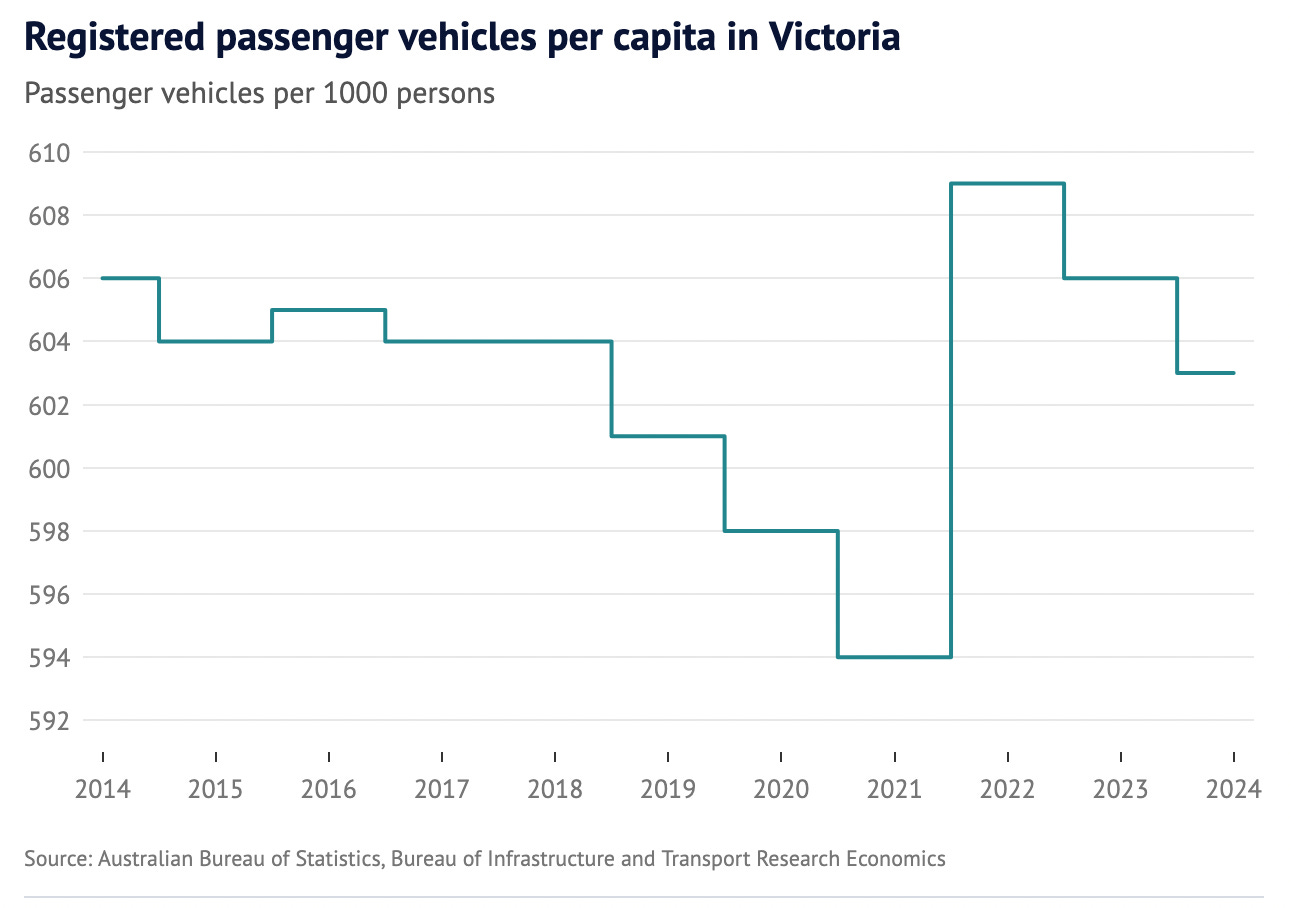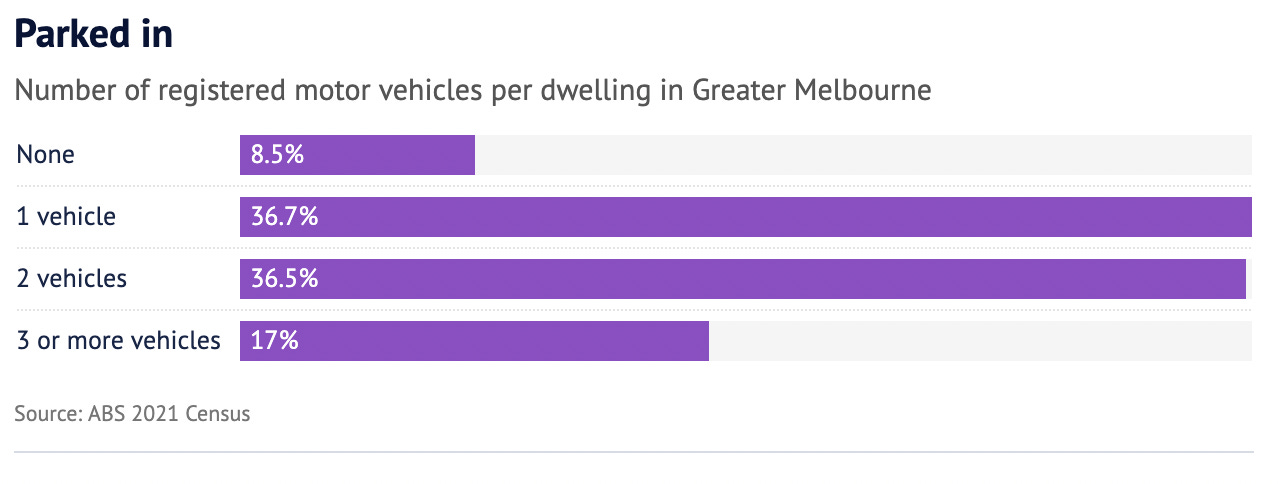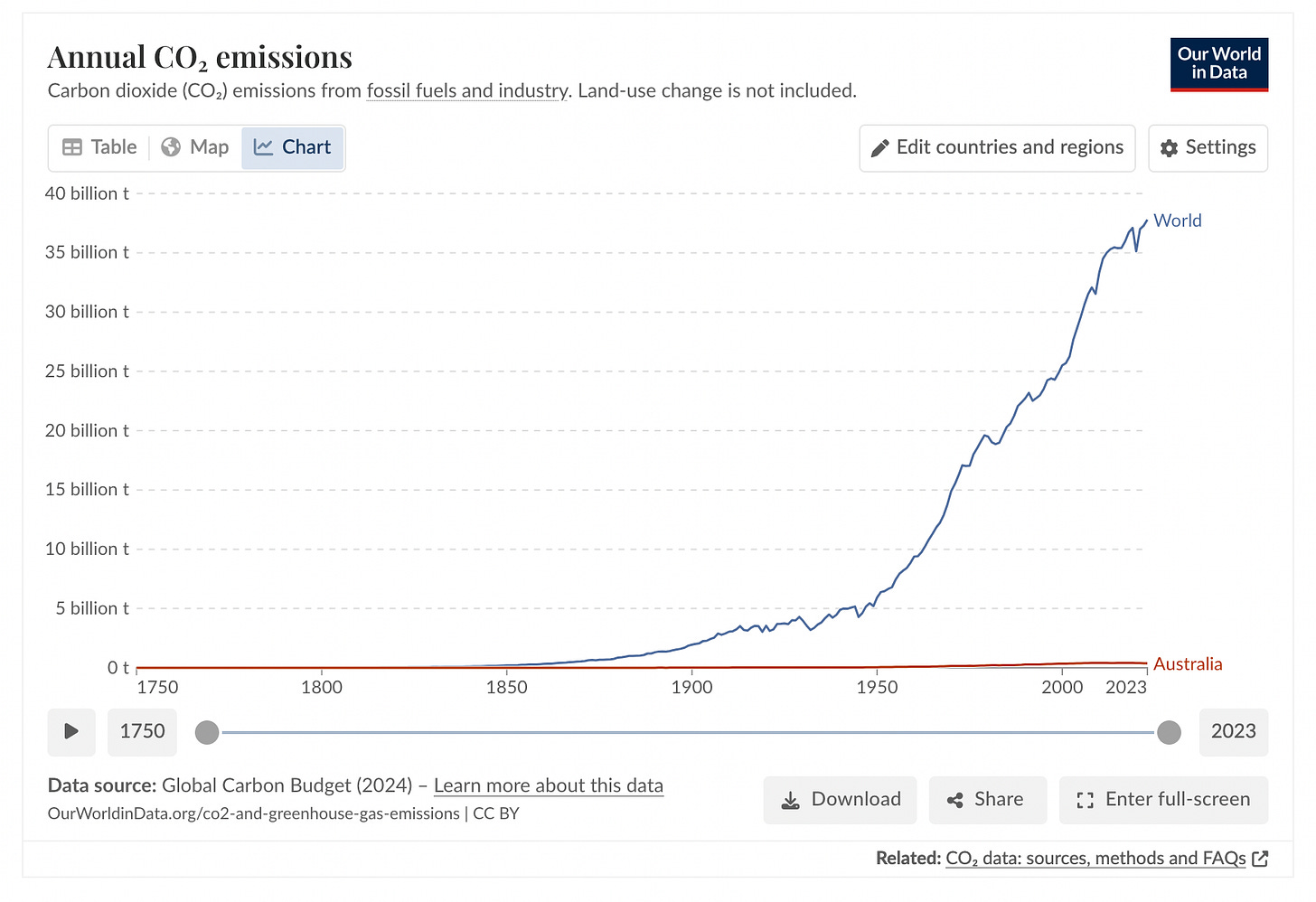Victoria's War on Cars
The newest plans of the State Government against car ownership is a lose-lose scenario.

“When you force an outcome, you get the opposite”
Second Principle of Valid Action — Silo
Public Transport - A Woeful Reality
If you use public transport here in Victoria somewhat regularly you probably have the PTV app on your phone. A couple of times last year (and just now) I asked the app to calculate the travel time between my house and my nearest train station. The app calculated that, on average, I am looking at between 27 to 43 minutes of total journey time, with 55 - 74% of that journey time walking, i.e., not using public transport. This does not include waiting time, of course, so, depending on when I leave, I am free to add another 30 minutes, on weekdays, and more on weekends. One of the routes offered is literally backwards — and this show how poorly planning was done: I have to catch the bus to the next station down the line, and then backtrack using the train, to get to the train station that is closest to my house. The insanity reaches peak Melbourne. I once walked the whole route — walking was actually faster than what the app showed if I relied on public transport.
If I used my car, on the other hand, I am looking at 3-5 minutes driving time, on my own schedule (no waiting time), on clean seats, and with the possibility to make a stop wherever I wanted to in case I needed to grab something for dinner, for example. For people who do not drive as much on a weekly basis having a car and driving it around might be more expensive in total if we added registration, insurance, and other running costs to the tally and compare it to using the not-so-cheap-either public transport, but for people who drive a lot and make multiple stops daily it is much cheaper to rely on the car, especially if their car is cheap to run. Even if everyone owned an expensive and inefficient car, Australians are so wealthy (and the alternative of relying on public transport is often so bad) that it makes more sense to pay more for using the car than waiting around for the next bus to come. Time is an extremely valuable resource, after all.
I am not alone: if you live far from a train line your options for public transport are bleak. Sometimes simply non-existent. But the State Government and some Councils seem nonetheless determined to make every Victorian live (and think) like an inner-city dweller, and reduce car ownership and usage. Long story short? It will not happen any time soon (if at all) and, once again, the wrong target population will pay the price.
Government Says Yeah. Evidence Says Nah
In case you missed it, the Victorian State Government recently announced that they will be pushing to implement 30 km/h zones in local streets Victoria-wide . The push comes on the back of the number accidents involving children and pedestrians in Victoria and, similar to other reports on the matter (e.g. here and here), it uses raw numbers to convey its message. A recent report published by Council Watch using data from the Department of Transport, however, shows a different reality. When you adjust by population growth (more people equals more accidents after all), the reality is that the rates of accidents is decreasing in time for all the severities of accidents analysed from 2012 to 2023.
Most importantly, the report also shows that reducing speed limits below 50 km/h does not reduce the likelihood of an accident becoming serious or fatal. I encourage you to read the full report.
Infrastructure Victoria’s current 30-year plan proposal also backs — if not leads — the push, but the evidence used to put forward the policy is misleading at best, and flawed at worst. For example, it claims that “road trauma is a leading cause of death for children aged 1 to 14 in Australia“ while citing figures from the Australian Institute of Health and Welfare, but without telling you how many of those die (i) as pedestrians or (ii) in local streets which is, effectively, the scope of the policy. The Victorian Transport Accident Commission (TAC) data on road trauma statistics shows that, in reality, only about 2 children (under 15 years old) on average have died each year between 2012 and 2024 as pedestrians. Moreover, the map view of the TAC data reveals that many — if not most — of these fatal accidents have happened on main roads, rather than on local streets. They also cite the Yarra Council as an example of a 30 km/h trial, but ignoring the fact that even the final report on the trial in 2020 concluded that “the likelihood of a serious or fatal injury (given a collision) before [trial implementation] was 0.24%, and 0.23% after [the trial].” Yes, you read that correctly: a meagre 0.01 point reduction. This is the zone of diminishing returns at its finest, since the Yarra Council also had to contend with a lot of general dissatisfaction by a good proportion of the residents while implementing the trial, on top of the cost of changing the speed signs.
Zooming out at Australia level, the national crash dashboard tells a similar story: the fataility rates are going down in general, and are nearly non-existent for pedestrians and children pedestrians, especially at lower speeds. External sources of evidence validate this: we have been experiencing a massive decline in fatality rates for the last 4 decades at least, as shown in data collated by ourworldindata, and our latest reductions in speed limits seem to have played little role in it — if any. I would be eager to hypothesise that technological advancements in braking power, braking assistance, sensors, and general car safety technology have had a much bigger contribution in this decline.
We should be celebrating the fact that Victoria and Australia are amongst the safest places on Earth to drive and be a pedestrian, but authorities seem to be all too eager to mislead the population and ignore their own data, instead of celebrating the successes we have harvested in recent years.
If pushing for 30 km/h zones was not enough, the government is also planning to slash car park availability near transport hubs, meaning several Councils would pay the price for this proposal since these changes would be implemented via Councils. At the behest of the State Government, Councils will cop the abuse of the general dissatisfied Victorian, especially if they do nothing to push back.
People and Businesses Also Say Nah
On the other side of the equation, Victorians are happy to own their cars. Data collated by The Age shows that the number of registered cars per 1,000 people in Victoria remains a consistent ~600 on average per year for the last 10 years, even as population grew from 5.8 million in 2014 to 7 million in 2024, according to ABS estimates.
Note, however, that the figures above (and as far as I can interpret) are per 1,000 people in general, and not per 1,000 people of driving age. The following data from the same article by The Age gets closer to the reality of Victoria: very few people of driving age are living without a car. How could it not be the case when we consider how far everything is, and how limited and time-wasting the public transport endeavour is?
The problem for the State Government is that people will not let go of their cars, even when car park spaces are reduced. When I was living in a small apartment complex years ago, the only thing that reduced car park availability translated into was an overparked front of the building, even when the building was a 15 minute walk to the train station. This is not simply anecdotal: the lack of public car parking spaces, especially in inner city settings, is a major source of frustration and fighting. Do note that we are talking about the inner city, where public transport works better and businesses are closer to where people live than in the outer and regional suburbs. If inner city people are holding onto their cars, what makes the State Government think the rest of us will be any more keen to let go of them?
People need their cars, after all, even in the presence of public transport, since Victoria is a big place with poorly planned and very limited public transport coverage. The conclusion would remain if we only focused on Melbourne and it had the best public transport network in the world, because metropolitan dwellers also regularly visit regional Victoria, and the ground-level behaviour of these people is a testament to their revealed preferences.
Not only this lack of public parking is a source of frustration for residents, but also for small business owners, as reduced on street parking leaves their premises unappealing for customer visits. This is not hard to imagine: considering people’s reliance on cars (and therefore on parking), how keen would they be to visit a place that has no parking spaces available? Maybe this might be less the case for the ultra-connected CBD, but what about suburbs such as Cheltenham, Clayton, Box Hill, Monash, Glen Waverley and Burwood, all of which will be trapped under the aforementioned reduced parking scheme? The macroeconomic results appear obvious to me: people will not ditch their cars, and will simply avoid going to places where they cannot park or where their public transport options are limited, especially if the time table of said public transport does not suit the busy schedules of the patrons. Small businesses will pay the biggest price in dwindling patronage, as drivers will naturally prefer larger shopping complexes that usually provide 3-hour free parking, and plenty of parking spaces.
Who Wins in the End?
Left unchecked, Victoria’s ongoing war on cars and drivers is set to claim multiple victims, but the casualty order appears far from what authorities might be envisioning. Small businesses will lose patronage in unforeseen numbers, Councils will become the whipping boys for the State’s mandates and lack of foresight (and insight) as the general people will see them as the face implementing the changes, and those who decide to play the game will do so with a bitter taste in their mouths. How many of those actually asked for any of this?
Yet it appears as if the State Government might also pay the price of their wilful blindness. As they push for more and more urban containment and densification via high rises and “urban hubs” around the suburban rail loop, how many people will choose to purchase these properties knowing they have limited to no parking space?
Data reported by YourMortage on a study commissioned by Uber Carshare shows that:
close to nine in 10 Australians say a private car space is one of the prioritised amenities when looking to move to a new home,
51% of Australians are willing to live outside their top suburb to ensure they have a private car space, and
77% of Australians are also willing to give up a backyard swimming pool to have a car space.
But not all generations feel the same way about the need for parking. Data reported by Lendi shows that older generations — those that will be disproportionately more able to afford the apartments the State Government plans on building — are those who desire the parking the most (as reflected in their willingness to pay more for it). And in the face of a lack of supply for their parking spots they might simply take their money elsewhere. In turn, therefore, those apartments will not sell for the profit they are required to sell, and the State government might have to foot the bill. Sorry, I meant to say that the taxpayer will pay for the State government’s unwillingness to let the market decide where to build, and how transport should be managed. Developers might not even want to build under such unappealing conditions, making the whole scheme pure fantasy.
Who wins in the long run? As the war on cars moves at a slow but steady pace, I am hard pressed to find anyone winning outside ideologues, statists, the Construction union, and the professional busybody and narcissistic class eager to make everyone do and live as they say — and God knows we have an oversupply of those here down under. Not even the Climate wins, as Australia’s carbon emission footprint is abysmally small, so activists thinking that ditching our cars is good for climate change are heavily misguided.
The above chart is also a kind reminder for those net-zero zealots who think Australia will make a difference at a global scale by wrecking our economy in the name of getting to net zero by 2050: we will not. If you want to see the effect of a Net Zero Australia in the world you can download the data above and do the math. Just a heads-up: you will have to squint real hard to see the effect.
It appears to me that, indeed, the only ones who win in our current ideology-filled political space (outside those who get paid to do the job, of course) are the ideologues themselves — the ones who will be the last to pay any price for being wrong about their decisions for the larger population.
But there is a glimmer of hope: if the current protests and resistance against the newest State Government tax — the Emergency Services and Volunteers Fund — by both volunteers, Councils and even the Chamber of Commerce and Industry are anything to go by, they might be signalling the start of what I honestly hope is the awakening of the State of Victoria to the havoc wrecked by the State Government’s economic mismanagement for the last decade — a crisis further deepened by the COVID era spending.
Whatever the future brings, one thing is clear: the future is full of cars. I say it’s time to embrace it.



